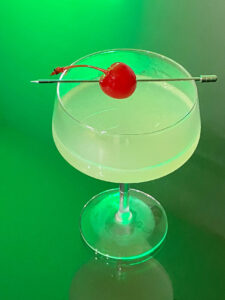Of all the negative consequences of the misguided exercise called Prohibition—organized crime, government corruption, economic decline, and an actual increase in deaths due to alcoholism and tainted moonshine—one downside is still with us: the loss of countless historic cocktails.
Some of those drinks still exist, of course—or at least the recipes do, in the pages of pre-Prohibition cocktail guides like Jerry Thomas’s How to Mix Drinks or the Bon Vivant’s Companion (1862), William “Cocktail Bill” Boothby’s The World’s Drinks and How to Mix Them (1908), and others. Original copies of these guides are worth thousands of dollars, but most are also available in cheaper facsimile editions or online from the incredible EUVS Vintage Cocktail Books Library. They make for fascinating perusal.
But in so perusing, you’ll quickly realize just how many of these 19th and early 20th century potions almost never appear on a 21st century bar menu. When was the last time you had a McLoughlin Cocktail (creme de cognac, frappéd champagne, and bitters) or a Rumfustian (gin, sherry, beer, egg yolk, cinnamon, nutmeg, and sugar)? Admittedly, demand for some of these drinks is nil; I can’t really imagine anyone craving a mixture of Rhine wine and seltzer or any drink containing poi.
Many vintage cocktails managed to survive the dry spell that lasted in the United States from 1920 to 1933—among them, the Sidecar, the Mint Julep, and of course the Old-Fashioned. Others vanished for decades but, thanks to the bold determination of a handful of mixologists, have enjoyed a much-deserved revival.
The Last Word was an upscale World War I-era cocktail that the teetotalers drove into hiding for about nine decades. According to The Oxford Companion to Spirits & Cocktails, the drink made a comeback in 2003, thanks to a bartender at the Zig Zag Cafe in Seattle, who put the Last Word on the menu and then watched as it quickly became popular across the country and around the world. And no wonder: The combination of gin, maraschino liqueur, Green Chartreuse, and lime juice shouldn’t really work, but it does. And that’s the last word I’ll say on the subject.
Corpse Revivers are a family of drinks that date back to 1850s London, where bartenders there touted them as “American-style” cocktails—despite the fact that no such drinks existed in the United States. Harry Craddock included a couple of variations in The Savoy Cocktail Book in 1930, billing them as morning elixirs (“to be taken before 11 a.m. or whenever steam and energy are needed”). But it wasn’t until the early 2000s that Craddock’s second version gained favor in American drinking establishments again.
Corpse Reviver (No. 2) features an unusual combination of spirits, including Cointreau and Lillet Blanc, but it’s the dash of absinthe that gives the drink its distinctive bitter edge. Is it really a morning drink? I don’t know, but at any time of day be sure to heed Craddock’s warning: “Four of these taken in swift succession will unrevive the corpse again.”
If you feel the need for a pre-noon pick-me-up like the ones in the olden days, you’d better be prepared for the Prairie Oyster. Called the Widow’s Dream in Boothby’s book, this is the kind of slap-across-the-face hangover cure I imagine being offered in a Victorian-era British pub or Old West saloon. It includes Worcestershire sauce, hot sauce, tomato juice, and malt vinegar; you can have it with or without the booze (cognac), but one ingredient is not optional: a raw egg yolk.
Drink it down in one gulp. And then ponder the possibility that some pre-Prohibition drinks should remain prohibited after all.
Last Word
Adapted from The Joy of Mixology by Gary Regan
3/4 ounce London dry gin
3/4 ounce maraschino liqueur
3/4 ounce Green Chartreuse
3/4 ounce fresh lime juice
Brandied or maraschino cherries for garnish
Add all liquid ingredients to a cocktail shaker with ice and shake. Strain in to a chilled cocktail glass. Garnish with a cherry or two.
Corpse Reviver (No. 2)
Adapted from The Savoy Cocktail Book by Harry Craddock
1 ounce gin
1 ounce Cointreau
1 ounce Lillet Blanc
1 ounce lemon juice
1 dash absinthe
Add all liquid ingredients to a cocktail shaker with ice and shake. Strain into a chilled cocktail glass. Garnish with lemon peel.
Prairie Oyster
Adapted from Difford’s Guide
1 fresh egg
1 ounce cognac (optional)
1/2 ounce malt vinegar
1/4 ounce Worcestershire sauce
1/4 ounce tomato juice
2 to 5 dashes hot sauce
2 pinches salt
2 grinds fresh black pepper
Carefully separate the egg yolk from the white; reserve the latter for other uses. Place yolk in the center of a chilled cocktail glass. Add other ingredients to a cocktail shaker with ice and shake. Strain over the egg. Down all at once.

